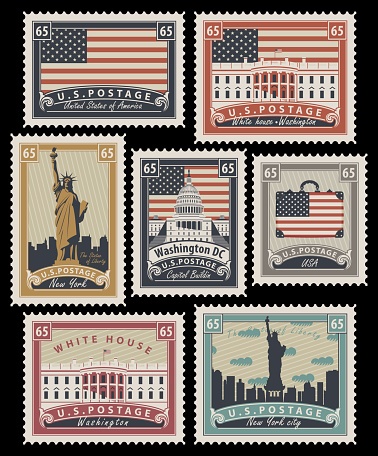Did you know that postage stamps are protected by copyright?

On July 1, 1847, the first federally issued postage stamps went on sale in the United States. While the use of postage stamps was not yet required by law—the recipient typically paid a postage fee to collect their mail from the post office—use of these stamps demonstrated that the postage was prepaid by the sender.
At the time, there were two options available: a five-cent stamp featuring a portrait of Benjamin Franklin, and a ten-cent stamp featuring President George Washington. Today, there are more than 80 different postage stamps available for purchase on the United States Postal Service website, including portraits of historical figures like George Washington and Richard Allen, famous musicians like Jimi Hendrix and Janis Joplin, comic book and cartoon characters, and many more photographs and illustrations.
While most of the works created by the federal government are not protected by copyright, Congress created an exception for works created by the United States Postal Service (USPS). But that hasn’t always been the case. In fact, the USPS has a complicated history when it comes to copyright.
Before there was a USPS, there was the United States Post Office Department (USPOD), a cabinet-level department within the executive branch, headed by the Postmaster General. In 1938, Congress passed legislation which stated that “copyright may be secured by the Postmaster General on behalf of the United States in the whole or any part of the publication authorized by this section,” including stamps. This was important because, prior to the passage of that 1938 legislation, the Copyright Act of 1909 held that “no copyright shall subsist…in any publication of the United States Government,” and as a cabinet-level department, stamps published by the USPOD clearly fell within these parameters, and outside of the scope of copyright protection. The 1909 Act was eventually amended to include the language from the 1938 legislation.
However, in 1964 while Congress worked to revise the Copyright Act, a “representative” of the USPOD stated that the provision which made postage stamps copyrightable was no longer necessary. A few years later, in 1970, Congress passed the Postal Reorganization Act, and the USPOD was replaced by the independent USPS that we know today. In 1975 as hearings were held to aid in the revision process, USPS changed course and recommended that the provision not be removed from the law. To complicate things even further, they also stated that it was the belief of the USPS that “the most sensible interpretation of the provision is that this postal statute did not intend to provide a title 17 copyright at all,” but rather “assigned authority to the Post Office Department in the nature of a general property right” and for that reason, rather than remove the provision altogether, they asked that it be moved out of Title 17 and back into its original place under Title 39. But the Copyright Office disagreed, both about USPS’s rather strange interpretation of the provision (an interpretation it no longer holds) and its newfound desire to move rather than delete the provision. Instead, the Office believed that the provision should be removed, not moved, because although the USPOD, as a cabinet department, needed an exemption in order to protect stamps via copyright, the newly reorganized USPS did not (perhaps because of its independent status).
Ultimately, Congress decided to keep the special provision in the 1976 Act, which empowers the USPS to “use the copyright law to prevent the reproduction of postage stamp designs for private or commercial non-postal services.”
Photo Credit: paseven/iStock/thinkstock

